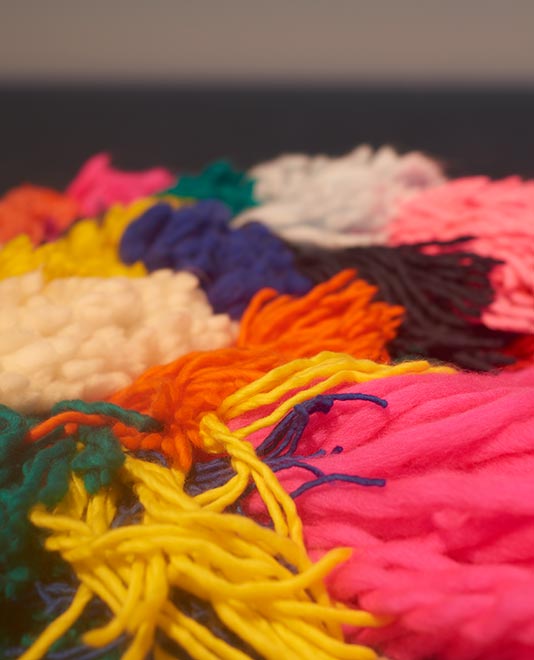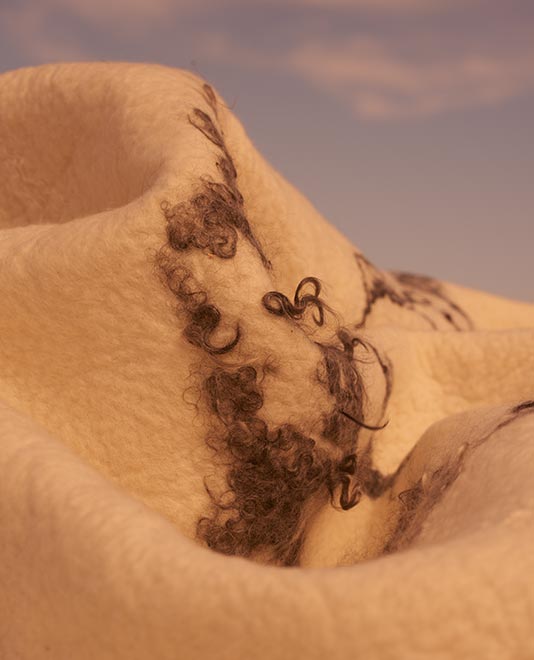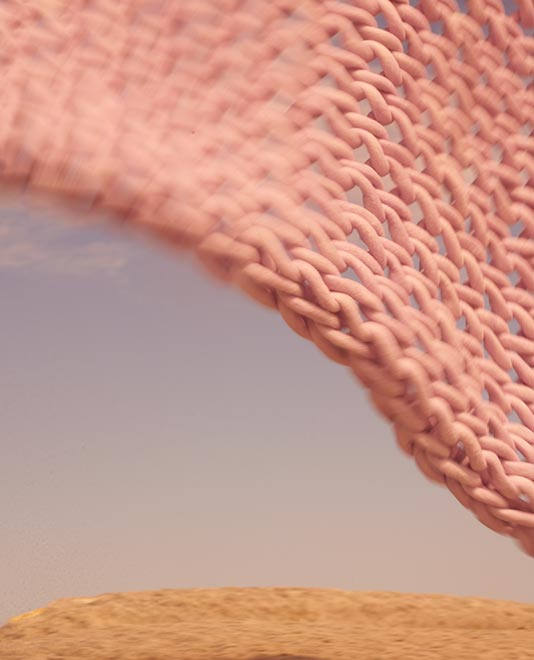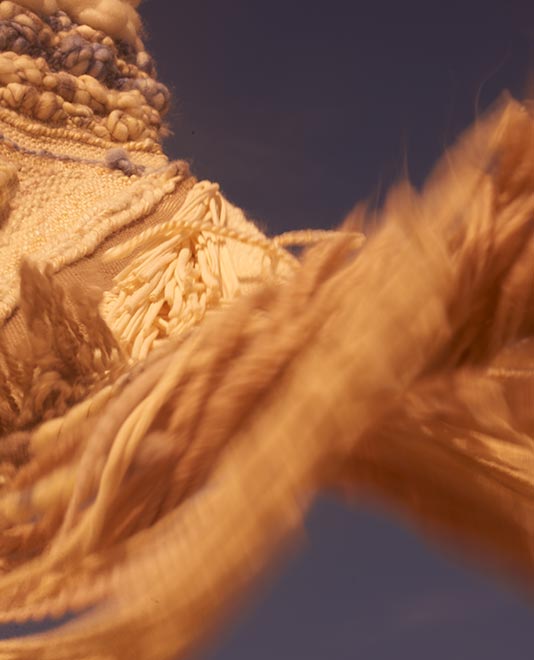Pushing back against the early 2000s dominance of video and digital art, a new generation of artists is reinventing traditional craftforms with wool.
In a world dominated by technology and the growing desire for instantaneous gratification, a counter-culture has emerged over the past few years with a philosophy of slowing down. As more people become interested in buying, or learning how to make, artisanal products, the popularity of the slow craft movement grows. Accessories such as scarves, beanies and gloves have benefited from this trend, as have home furnishings such as luscious throws, cosy cushions and woven wall hangings. Yarn crafts are not only admired for their aesthetic beauty, but also for meditative, therapeutic benefits.
“While handmade is as old as time itself, only in recent decades has craft, DIY and handmade been adopted as a stalwart of popular culture, used as a way to challenge the status quo to encourage social change and to create a meaningful and constructive dialogue about how we can all live better, do better and be better,” explains extreme knitter Jacqueline Fink. Her brand, Little Dandelion, is loved by stylists across the world. By handcrafting stunning blankets, throws, wall hangings and home furnishings, Fink takes knitting to its extreme; a quiet rebellion against mass production. “When I started my particular process of large-scale knit-ting Merino woollen tops, I was very much on my own. It took a couple of years for the market to catch on but now extreme knitting, in all its numerous (and some questionable) forms, is without a doubt a global trend taken up by crafters in the thousands.”
Knitters have long thought that knitting could be an excellent therapy – the repetition is both meditative functional. Fink is quick to attest to the ancient craft's benefits to mental health and well-being. Having suffered from both post-natal depression and anxiety, the mother of three’s life started to turn around once she started extreme knitting. “Since delving into the world of wool and knitting I have found solace, peace, joy, affirmation and mind-fulness. I no longer suffer from depression and completely manage my anxiety as well as anyone else.”


(Left) Natalie Miller wool wall hanging. (Right) Grace Wood Design Studio wool bed cover.
“The meditative effect of knitting is thought to reduce stress,” explains Pat Pillai, co-founder of Neural Knitworks in Sydney, a collaborative project that uses yarn arts to craft healthy brains. “Concentrating on so many things at once keeps you engaged and focussed on the here and now, and can induce a state of flow, similar to that achieved in meditation. This reduces blood pressure and promotes breathing, blocking negative thoughts.” Pillai refers to articles by neuroscientist Dr Sarah McKay, who cites a Betsan Corkhill survey that concluded: “Knitting has significant psychological and social benefits, which can contribute to well-being and quality of life.” Neural Knitworks plans to exhibit an artwork made of woollen “neurons” to draw attention to its key message. It has been hosting regular knit-ins and workshops to allow members of the public (and even of the neuroscience community) to contribute to the collective knitting project.
“I was very much drawn to felting when I was experiencing a stressful health circumstance," says textile artist Grace Wood. "It helped me to get out of my head and into my hands, and to focus on the sensation of the soft fibres and rhythmic rubbing, rolling, and occasional throwing of the shrunken matted felt fabric. Through felting and weaving I have encountered a space for meditation and release, and that wonderful sense of flow.” Wood creates stunningly tactile interior textile products from Australian wool. She takes an organic approach to her work by personally dyeing the felted wool with natural plant extracts, including cochineal, weld, madder, dahlia, onion, turmeric and indigo. These form some of the sources of the rich and vibrant colours seen in her work. Wood believes that hands-on and DIY crafts have become popular because they allow the craftsperson to connect on a daily basis with all things natural. "I think with this renaissance has come a re-education around the process of making,” says Wood. “In the recent past, there has been little regard for how a product was made or who made it. Taking a piece of wool top or yarn and turning it into cloth by hand, and then into a garment or cushion cover, is inextricably tied to the value and integrity of the product, and I think people appreciate and respond positively to that."
This sentiment is echoed by fellow textile artist and self-described dream weaver Natalie Miller, whose large-scale artworks are big and bright, and beg to be touched. She uses her expertise in weaving and macramé to teach others how to create intricate and joyful wall hangings out of home dyed wool yarns. “I believe people are yearning making with their hands again, and having a break from computers and technology,” explains Miller. “To remove yourself from the screen and be able to make something is absolutely rewarding and good for the soul. Weaving is an extremely meditative process and I believe the act of making is very important for one’s mental state. Whether its weaving, knitting, knotting or other making, just being in that meditative state of repetitious movement can be extraordinarily calming.


(Left) Little Dandelion extreme knitted wool throw. (Right) Crossing Threads wool wall hanging.
Due to its many virtues, such as its ability to provide excellent acoustic insulation, wool – the soft, yet intensely durable, natural fibre – is one of the most popular supplies for textile artists. “There is no substitute for wool: it has beautiful tactile qualities and it's durable,” affirm Laurens and Hernandez. Lauren, and her sister Kass, make up Crossing Threads, a creator of highly textural, organic and intricate handwoven fibre art. By drawing inspiration from the beautiful Australian landscape, and by using natural fibres adventurously, the sisters aim to push the boundaries of woven wall art.
“In our fast-paced society, time has become a luxury and hence there has been growing appreciation of handmade products which have become a symbol of the sheer effort put into these bespoke pieces,” Kass explains. “There is something special about bringing home handmade keepsakes into our interiors or clothing, which may become fond memories and even family heirlooms to be passed down. Through weaving in particular, our practice involves the use of wool-based fibres, incorporating both traditional and innovative techniques to inject a new perspective into the ancient craft, through a Gen-Y lens. As we shift towards the slow life, we yearn to go back to basics to the therapeutic nature and appeal of fibre art.”
Consumers want to introduce tactility, warmth, texture and, above all, soul into their homes. To provide this, textile artists are turning to natural fibres like wool. “The process of extreme knitting engages every part of me, allowing my un-conscious mind to have a rest for a while,” concludes Fink. “It’s magic. Add the tactility, luxury and sensory delight of a beautiful natural fibre such as wool, and it takes the process to another level. Wool is a special ancient fibre that has provided humankind with warmth, comfort and protection for centuries. It has a rich and evocative beauty that is mesmerising, soothing and satiating. It’s role in my recovery from what was a very difficult time in my life cannot be overstated.”
